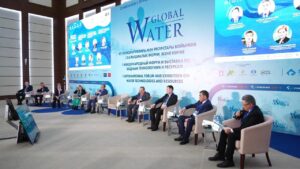ASTANA – Deputy Agriculture Minister Azat Sultanov discussed Kazakhstan’s advancements in water-saving technologies and sustainable water resource management at the Global Water international exhibition, reported the ministry’s press service on Feb. 25.

Press service of the Ministry of Agriculture of the Republic of Kazakhstan. Photo credit: Ministry of Agriculture
Sultanov emphasized the pressing need for water-saving technologies to enhance the efficiency of irrigated agriculture. These technologies are vital in reducing water consumption and boosting crop yields by precisely delivering water and nutrients.
To stimulate farmers to adopt water-saving technologies, the ministry provides state support through investment subsidies and subsidies for water supply services.
“With a 50% reimbursement of costs for modern irrigation systems and the provision of necessary water infrastructure, we have expanded water-saving technology implementation to 91,000 hectares since 2020, reaching a total of 312,200 hectares,” said Sultanov.
New investment subsidy rules, effective since December last year, increase the reimbursement share for drilling wells on irrigated lands from 50% to 80%, with 30% subsidized from local budgets.
In 2023, approximately 18.4 billion tenge ($40.7 million) were allocated for irrigation projects under investment subsidies, with a planned 14.6 billion tenge ($32.3 million) for this year.
Sultanov highlighted changes in the rules for subsidizing water supply services to farmers, where subsidies now vary based on irrigation methods.
“There are plans to expand the application of water-saving technologies to 150,000 hectares annually, with a detailed breakdown for each akimat (city administration) considering regional capabilities,” he said.
Diversification efforts in sown areas, accounting for regional specifics and market demands, include a projected reduction of 6,000 hectares in rice areas for 2023. By 2028, the aim is to decrease areas by 21,000 hectares, bringing the rice cultivation area to 79,000 hectares.
Sultanov emphasized the primary objective of increasing production profitability by reducing production costs. To achieve this, the ministry will promote the adoption of modern agricultural technologies, encompassing quality fertilizers, seeds, pesticides, and efficient machinery. The goal is to boost rice yields without compromising the overall rice production volume.

